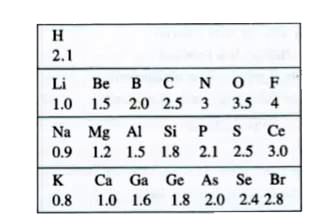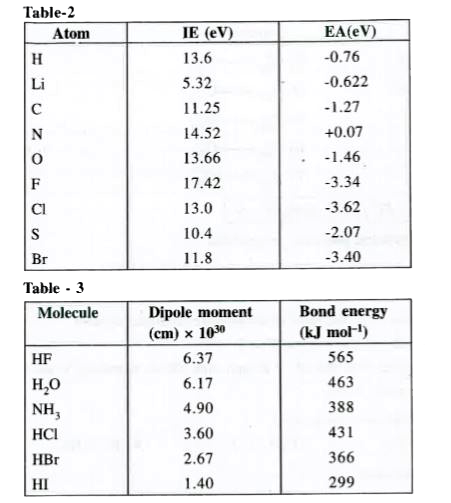The concept of electronegativity (EN) is mainly to discuss the nature of chemical bonding, EN of an atom is the measure of its capacity to attract the shared electron pair towards itself. Linus Pauling compiled the values of EN that are most widely used, and that are displayed for a few elements in Table - 1. These values are based on bond energy differences between atoms bonded to themselves (e.g. A-A) and to other atoms (e.g. A-B), and an arbitary value of 4 to fluorine (most electronegative element)

Mulliken regarded electronegativity as the average value of ionization energy and electron affinity of an atom EN=12(IE+EA). Both IE and EA are expressed in electron volts. In the Table-2, values of IE and EA for several elements are listed Table-3 shows the values of dipole moments and bond energies for simple molecules.

Based upon the electronegativity difference of bonded atoms, which of the following about the chemical bond?Solution in Telugu
Ionic if ΔEN<1.2, Polar covalent if ΔEN>1.2
Ionic if ΔEN>1.2, Polar covalent if ΔEN<1.2
Ionic if ΔEN<2.0, Polar covalent if ΔEN>2.0
Ionic if ΔEN<2.0, Polar covalent if ΔEN<2.0
The correct Answer is:D
Step by step video & image solution for The concept of electronegativity (EN) is mainly to discuss the nature of chemical bonding, EN of an atom is the measure of its capacity to attract the shared electron pair towards itself. Linus Pauling compiled the values of EN that are most widely used, and that are displayed for a few elements in Table - 1. These values are based on bond energy differences between atoms bonded to themselves (e.g. A-A) and to other atoms (e.g. A-B), and an arbitary value of 4 to fluorine (most electronegative element) Mulliken regarded electronegativity as the average value of ionization energy and electron affinity of an atom EN=1/2(IE+EA). Both IE and EA are expressed in electron volts. In the Table-2, values of IE and EA for several elements are listed Table-3 shows the values of dipole moments and bond energies for simple molecules. Based upon the electronegativity difference of bonded atoms, which of the following about the chemical bond? by Chemistry experts to help you in doubts & scoring excellent marks in Class 11 exams.
Related Playlists
- BOOK - AAKASH SERIESCHAPTER - PERIODIC PROPERTIESEXERCISE - LEVEL-II (TYPE-I) (PRACTICE SHEET-2( MATCHING))1videos
PERIODIC PROPERTIES
- BOOK - AAKASH SERIESCHAPTER - PERIODIC PROPERTIESEXERCISE - LEVEL-II (TYPE-I) (LECTURE SHEET-3 (MORE THAN ONE CORRECT ))5videos
PERIODIC PROPERTIES
- BOOK - AAKASH SERIESCHAPTER - PERIODIC PROPERTIESEXERCISE - LEVEL-II (TYPE-I) (PRACTICE SHEET-2(MORE THAN ONE CORRECT ANSWER))5videos
PERIODIC PROPERTIES
- BOOK - AAKASH SERIESCHAPTER - PERIODIC CLASSIFICATIONEXERCISE - OBJECTIVE EXERCISE - 3 (RECENT AIPMT/NEET QUESTIONS)14videos
PERIODIC CLASSIFICATION
- BOOK - AAKASH SERIESCHAPTER - PERIODIC TABLEEXERCISE - EXERCISE ON PASSAGE12videos
PERIODIC TABLE
Similar Questions
Match the following
 01:23View Solution
01:23View SolutionWhich of the following statements are correct ?
02:35View SolutionAmongst the following statements, which is(are) correct ?
01:50View SolutionWhich one of the following orders is not in accordance with the property stated against it?
03:39View SolutionPASSAGE - 1: In Mendeleeff's periodic table elements were classified on the basis of atomic weight & in modern periodic table on the atomic number. The lighter elements of 2 & 3 periods show similarities in their properties called diagonal relationship
1. Which of the following element is not present in Mendeleeff's periodic tableView SolutionWhich of the following numerical scales of electrongativity (EN) uses the concept of bond energies?
View SolutionElectronegativity is defined as attracting power of sharing pair of electron between covalently bonded atoms. Electronegativity is defined on different scales, F has height electronegativity between all elements. Which of the following oxide is basic in nature ?
02:10View SolutionIf the electron pair is unequally shared between the bonded atoms, it results in ______ bond.
01:35View SolutionThe relative tendency of a bonded atom in a molecule to attract the shared pair of electrons towards itself is termed as ___________
00:53View SolutionThe tendency to attract a shared pair of electrons towards itself in a covalent bond is called _____________
03:37View SolutionIf the electronegativity difference between bonding atoms is 1.7 then the chemical bond is nearly
06:01View SolutionIf the electronegativity difference between bonding atoms is 1.7 then the chemical bond is nearly
03:18View SolutionThe energy of electron in an atom is given by En =
01:08:36View SolutionThe energy of electron in an atom is given by En =
01:54View SolutionHow electronegativity values help to find out the nature of bonding between atoms?
01:39View Solution


